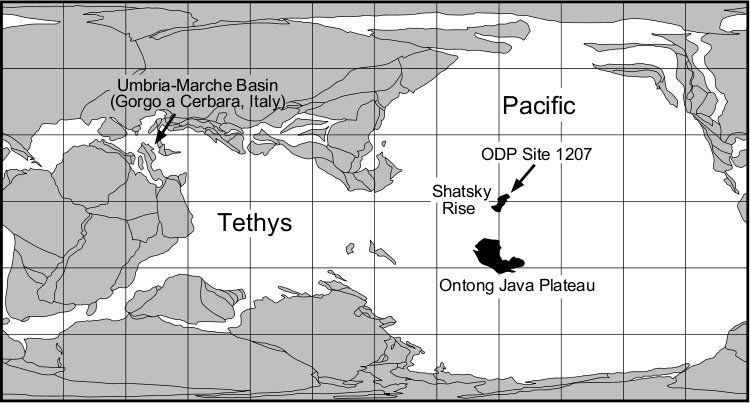July 2011 LIP of the Month
Lead isotopic record of Barremian-Aptian marine sediments from Pacific and Tethys: implications for large igneous provinces and the Aptian climatic crisis
Junichiro Kuroda1, Masaharu Tanimizu2, Rie S. Hori3, Katsuhiko Suzuki1,4, Nanako O. Ogawa5, Maria L.G. Tejada1, Millard F. Coffin6, Rodolfo Coccioni7, Elisabetta Erba8, Naohiko Ohkouchi5
1 Institute for Research on Earth Evolution, Japan Agency for Marine-Earth Science and Technology (JAMSTEC), Yokosuka 237-0061, Japan; kurodaj@jamstec.go.jp
2 Kochi Institute for Core Sample Research, JAMSTEC, Nankoku 783-8502, Japan
3 Graduate School of Science and Engineering, Department of Science, Ehime University, Matsuyama 790-8577, Japan
4 Precambrian Ecosystem Laboratory, JAMSTEC, Yokosuka 237-0061, Japan
5 Institute of Biogeosciences, JAMSTEC, Yokosuka 237-0061, Japan
6 Institute for Marine and Antarctic Studies, University of Tasmania, Hobart, Tasmania 7001, Australia
7 Dipartimento di Scienze dell'Uomo, dell'Ambiente e della Natura, Universita di Urbino, Campus Scientifico, Località Crocicchia, 61029 Urbino, Italy
8 Dipartimento di Scienze della Terra “A. Desio”, Universita di Milano, Via Mangiagalli 34, Milan 20133, Italy
Here we introduce our paper recently published in Earth and Planetary Science Letters (Kuroda et al., 2011). In this article, we present temporal variations in lead isotopic ratios for Early Cretaceous (Barremian–Aptian) sections from Shatsky Rise, central Pacific and Gorgo a Cerbara, central Italy (Figure 1). Our Pb isotopic data track an interval representing Oceanic Anoxic Event (OAE)-1a, which is characterized by quasi-global deposition of organic carbon-rich black shales. The sedimentary Pb isotopic record could be an excellent tracer for seeing temporal change in sediment provenances (e.g., Kuroda et al., 2007). Lead isotopic compositions of sediments from Shatsky Rise decrease at the end of Barremian time, from radiogenic continental values to unradiogenic values, and subsequently remained less radiogenic until the end of early Aptian time (Figure 2a). We explain the isotopic shift by a significant increase in the supply rate of unradiogenic Pb, most likely due to massive volcanism. In contrast, the Pb isotopic compositions from the Italian section, which was situated at the western end of Tethys, are mostly identical to those of upper continental crust, showing no significant change in supply rate of unradiogenic Pb (Figure 2b). The discrepancy in sedimentary Pb isotopic records between two sites is attributed to quiescent deep-submarine eruptions of Pacific large igneous provinces (LIPs) such as the Ontong Java Plateau (OJP), which severely limited dispersion of Pb-carrying particles out of the Pacific Ocean. Previously published Os isotopic data from the Italian section indicate two episodes of massive eruptions of OJP or contemporaneous Manihiki and Hikurangi plateaus starting from earliest Aptian time, slightly later than that indicated by the sedimentary Pb isotopic record from Shatsky Rise (Tejada et al., 2009). Differences in isotopic variations between Pb and Os likely reflect differences in their chemical behaviors in the oceans, i.e., Pb isotopic compositions would have varied in response to local or regional changes in sediment provenances, whereas large-scale changes in Os inputs are required to explain variations in seawater Os isotopic compositions. Our Pb isotopic data, together with the previously published Os isotopic record (Tejada et al., 2009), provide further evidence for the eruptive history of OJP or contemporaneous Pacific plateaus. We also examined its environmental consequences from end-Barremian through early Aptian time, such as change in calcareous nannoplankton composition and abundance (Erba, 2004), change in carbon isotopic composition, and deposition of organic carbon-rich sediment.

Kuroda et al., Figure 1: Location map for Early Aptian time (120 Ma). Paleogeographic reconstruction is modified after Schettino and Scotese (2000). Reconstructions of the Shatsky Rise and the Ontong Java Plateau are after Bralower et al. (2002) and Riisager et al. (2003), respectively.

Kuroda et al., Figure 2: Cross plots of 206Pb/204Pb versus 208Pb/204Pb for cores from Site 1207B of Shatsky Rise (a) and sediments from the Gorgo a Cerbara section (b). White diamond―Barremian sediment; black square―early Aptian sediment; and light gray triangle―late Aptian sediment. OJP (KK)―Kwaimbaita-Kroenke type basaltic rocks of Ontong Java Plateau (Mahoney et al., 1993; Tejada et al., 1996, 2002, 2004); OJP (Sin)―Singgalo type basaltic rocks of OJP; MP (DSDP 317)―Basaltic rocks from DSDP Site 317A, High Plateau of Manihiki Plateau (Hoernle et al., 2010; Ingle et al., 2007; Mahoney and Spencer, 1991; Timm et al., 2011); MP (DIT)―Dredged samples of basement basalt from Danger Island Trough, Manihiki Plateau; HP―Dredged samples of basement basalt from Hikurangi Plateau (Hoernle et al., 2010). The Pb isotopic ratios of upper continental crust are based on Allègre et al. (1996) and Millot et al. (2004).
References
Allègre, C.J., Dupré, B., Négrel, P., Gaillardet, J., 1996. Sr-Nd-Pb isotope systematics in Amazon and Congo River systems: constraints about erosion processes. Chemical Geology 131, 93-112.
Bralower, T.J., Premoli Silva, I., Malone, M.J., et al., 2002. Proceedings of ODP, Initial Reports [CD-ROM], vol. 198. Ocean Drilling Program, College Station, TX,
Erba, E., 2004. Calcareous nannofossils and Mesozoic oceanic anoxic events. Marine Micropaleontology 52, 85-106.
Hoernle, K. Hauff, F., van den Bogaard, P., Werner, R., Mortimer, N., Geldmacher, J., Garbe-Schönberg, D., Davy, B., 2010, Age and geochemistry of volcanic rocks from the Hikurangi and Manihiki oceanic Plateaus. Geochimica Cosmochimica Acta 74, 7196–7219.
Ingle, S., Mahoney, J.J., Sato, H., Coffin, M.F., Kimura, J., Hirano, N., Nakanishi, M., 2007. Depleted mantle wedge and sediment fingerprint in unusual basalts from the Manihiki Plateau, central Pacific Ocean. Geology 35, 595-598.
Kuroda, J., Ogawa, N.O., Tanimizu, M., Coffin, M.F., Tokuyama, H., Kitazato, H., Ohkouchi, N., 2007. Contemporaneous massive subaerial volcanism and late cretaceous Oceanic Anoxic Event 2. Earth and Planetary Science Letters 256, 211-223.
Kuroda, J., Tanimizu, M., Hori, R.S., Suzuki, K., Ogawa, N.O., Tejada, M.L.G., Coffin, M.F., Coccioni, R., Erba, E., Ohkouchi, N., 2011, Lead isotopic record of Barremian-Aptian marine sediments: implications for large igneous provinces and the Aptian climatic crisis. Earth and Planetary Science Letters 307, 126-134, doi:10.1016/j.epsl.2011.04.021.
Mahoney, J.J., Spencer, K., 1991. Isotopic evidence for the origin of the Manihiki and Ontong Java oceanic plateaus. Earth and Planetary Science Letters 104, 196-210.
Mahoney, J. J., Storey, M., Duncan, R.A., Spencer. K.J., Pringle, M.S., 1993. Geochemistry and age of the Ontong Java Plateau. In: M.S. Pringle, et al. (Eds.), The Mesozoic Pacific. Geology, tectonics, and volcanism. American Geophysical Union Geophysical Monograph, vol. 77, p. 233-261.
Millot, R., Allègre, C.J., Gaillardet, J., Roy, S., 2004. Lead isotopic systematics of major river sediments: a new estimate of the Pb isotopic composition of the Upper Continental Crust. Chemical Geology 203, 75-90.
Riisager, P., Hall, S., Antretter, M., Zhao, X., 2003. Paleomagnetic paleolatitude of Early Cretaceous Ontong Java Plateau basalts: implications for Pacific apparent and true polar wander. Earth and Planetary Science Letters 208, 235-252.
Schettino, A., Scotese, C.R., 2000. A synthetic APWP for Africa (Jurassic–Present) and global plate tectonic reconstructions. Eos Transactions AGU 81 19, S180.
Tejada, M.L.G., Mahoney, J.J., Neal, C.R., Duncan, R.A., Hawkins, M.P., 1996. Age and geochemistry of basement and alkalic rocks of Malaita and Santa Isabel, Solomon Islands, southern margin of Ontong Java Plateau. Journal of Petrology 37, 361-394.
Tejada, M.L.G., Mahoney, J.J., Neal, C.R., Duncan, R.A., Petterson, M.G., 2002. Basement geochemistry and geochronology of Central Malaita, Solomon Islands, with implication for the origin and evolution of the Ontong Java Plateau. Journal of Petrology 43, 449-483.
Tejada, M.L.G., Mahoney, J.J., Castillo, P.R., Ingle, S.P., Sheth, H.C., Weis, D., 2004. Pin-pricking the elephant: evidence on the origin of the Ontong Java Plateau from Pb-Sr-Hf-Nd isotopic characteristics of ODP Leg 192 basalts. In: J.G. Fitton, J.J. Mahoney, P.J. Wallace, and A.D. Saunders, (Eds.), Origin and Evolution of the Ontong Java Plateau. Geol. Soc. London Spec. Pub., vol. 229, p. 133-150.
Tejada, M.L.G., Suzuki, K., Kuroda, J. Coccioni, R., Mahoney, J.J., Ohkouchi, N., Sakamoto, T., Tatsumi, Y., 2009. Ontong Java Plateau eruption as a trigger for the Early Aptian oceanic anoxic event. Geology 37, 855-858, doi:10.1130/G25763A.1.
Timm, C., Hoernle, K., Werner, R., Hauff, F., van den Bogaard, P., Michael, P., Coffin, M.F.,2011. Age and geochemistry of the oceanic Manihiki Plateau, SW Pacific: new evidence for a plume origin, Earth and Planetary Science Letters 304, 135–146. doi:10.1016/j.epsl.2010.01.025.
